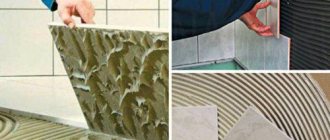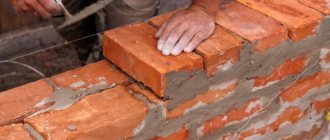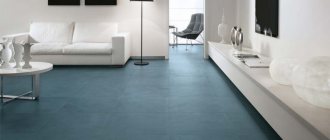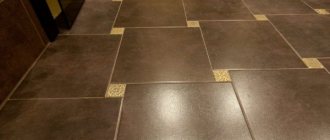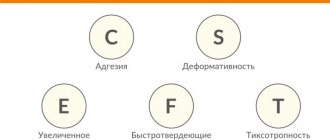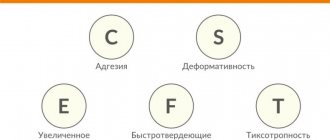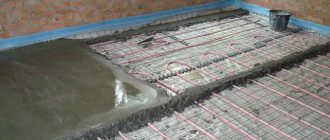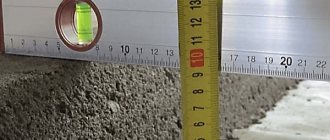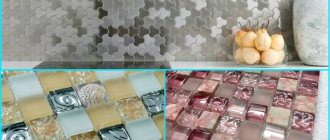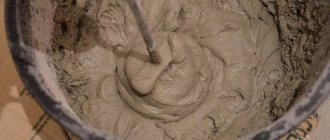Tiles are one of the most popular finishing options for various rooms. Tiles are made from different materials and come in different lengths and thicknesses. In order for the attachment to the base (walls, floor, ceiling) to be strong and durable, you must not only choose the right glue, but also observe some nuances. An important point is the thickness of the adhesive layer under the tile being mounted.
Individual choice of tile adhesive thickness
There is no generally accepted advice regarding the required amount of glue, since facing work in each specific case has its own specifics. The required thickness of the glue may well be just two or three millimeters or a whole centimeter.
The smaller the area of each individual tile square, the thinner the layer of adhesive applied to it should be. It is also important to consider the type of decorative tiles.
For example, when decorating a wall with porcelain tiles, less mortar will be needed than with regular tiles.
Application rules
When working with cement, in order for the glue to obtain all its necessary characteristics, it is mixed with water. The liquid should be added gradually. After mixing, the solution should be left for a couple of minutes, then mixed again until a thick mass is formed.
Reference! To distribute the adhesive mixture of the required thickness, use a spatula with teeth of the required size. The solution is applied directly to the floor, and if there are uneven areas, to the tiles.
To distribute the adhesive composition on the floor, you need to start work from the far corner, moving to the exit, so as not to step on the composition. Floor tiles are usually large in size, so a trowel with large teeth is used.
When laying tiles on the floor, you need to make a thick layer. This is due to the fact that afterwards you will need to drive out the voids by tapping with a mallet. The glue will be partially distributed and its volume will decrease. Excess solution can then be removed with a rubber spatula.
Laying porcelain stoneware requires preparation:
- Checking the quality of the base. Porcelain tiles can only be laid on load-bearing concrete foundations. Use a level to check horizontality. If there are significant differences, you will need to use more glue.
- Base primer. Can be done up to two times if the base quickly absorbs liquid. It is best to prime with a roller; the floor must first be cleaned.
Priming the surface before facing is of great importance. This increases the strength of the cement-sand base, preventing the coating from crumbling. This is also important for better adhesion. Adhesion after priming increases by approximately 20%.
The priming procedure also reduces the level of moisture absorption. Cement adhesive must remain wet for a certain time to gain strength. Before laying tiles, you need to wait until the floor is dry.
When laying porcelain tiles, you need to make sure that the glue does not protrude along its edges. This problem can be avoided if, before laying the next tile, remove a little mortar from the edge of the previous one with a spatula. The strip removed should not exceed a centimeter. If glue gets on porcelain tiles, you can remove it with a damp cloth. It is especially important to clean structured tiles before the adhesive hardens, which will simplify finishing work.
If you have little experience in laying tiles, you should lay no more than 2 layers at a time. Do not allow the glue to thicken. If this happens, you need to prepare a new portion. Do not dilute the finished thickened composition with liquid; the glue will lose its properties.
Considering all these factors, determining the thickness of the substance will not be as difficult as choosing the appropriate glue. To work with porcelain stoneware, it is better to use cement mixtures that are prepared immediately before the start of cladding.
Reference! You should pay attention to well-known companies that have already earned the trust of professional craftsmen. These are adhesive compositions from Ceresit, Knauf, Rusean, Yunis.
Manufacturers always indicate on the packaging information about the composition, consumption and nuances of use. You can also always call consultants to get answers to your questions. It is necessary to distinguish the original from the fake. Signs of the latter will be uneven, small letters on the packaging, and a careless appearance.
Correctly determining the thickness of the adhesive will allow you to calculate the required amount of glue, as well as securely fix the tiles for long-term use. You should always be prepared for the fact that some areas will require more glue and others less. You should buy adhesive with a small supply.
Calculation of adhesive thickness for porcelain tiles (2 videos)
Laying porcelain tiles on the floor (15 photos)
Equipment for laying tiles
How to avoid interior thresholds
When calculating the thickness of tile adhesive, you need to focus on how exactly other types of decor are laid in other rooms of the apartment.
This will prevent the formation of unplanned thresholds at the junctions of floor tiles with:
- Insulated linoleum;
- Layer of laminate;
- Highly laid parquet.
Summing up
Yes, the correct thickness of the adhesive will allow you to use the finished surface for a long time, increase the strength characteristics and protect the ceramics from premature cracks, chips and buckling. To achieve an excellent result, you need to do high-quality preparatory and measuring work. Measure corners and walls, pierce the floor base with a level, clean all surfaces from dirt, dust and uneven surfaces.
Beauty and durability to your ceramics!
How to carry out external cladding in the cold season?
At temperatures below +5°C, cement hydration practically does not occur; ordinary tile adhesive freezes and does not adhere to the tiles. After the onset of a thaw, the tiles peel off.
Types of tile adhesive
When calculating the amount of glue needed and the thickness of its layer, you must also take into account the type of adhesive solution used. These indicators largely depend on the chemical compounds used in the manufacture of the adhesive substance. For example, the cement mixture can be applied in a higher layer.
Forms of porcelain stoneware cladding
Two types of floor coverings are used - ceramic tiles and porcelain stoneware. In the manufacture of the latter, pressing and subsequent very strong heating are used, or, to be more precise, baking. This allows you to create elements that can withstand significant loads.
The standard for the production of porcelain stoneware slabs is provided not only for the process itself, but also for their shape and size. They can have a square shape, be produced in the form of a pentahedron, hexagon, or octahedron. In addition, modules may differ in parameters (side length).
Small tiles and mosaic tiles
The dimensions of the fragments of the decorative coating are essential for the correct selection of the height of the adhesive layer. When using small format tiles with sides of about 10 cm, the thickness of the mortar should be no more than two millimeters.
If the tile used turns out to be even smaller in size, for example, with a square side of 5-7 cm, then the layer of mortar after pressing the cladding should not exceed one and a half millimeters.
Seam width
Seams can be from 1 to 10 millimeters wide. It depends on the type, geometry and size of the tile used. As a rule, the seam width is 2 millimeters.
Grouting processSource otlichnyjremont.ru
When performing the correct layout, the width and length of the seams can be ignored.
For example, there is a wall 1.5 meters long and a tile 0.4 meters long. Algorithm of actions:
- Measure the length of the wall - 1.5 meters.
- Calculate how many meters you can cover with whole uncut tiles: 0.4 * 3 = 1.2 meters.
- Subtract one tile: 1.2 – 0.4 = 0.8.
- Subtract this size from the length of the wall: 1.5 – 0.8 = 0.7 meters.
- Divide into two parts because the tiles will be cut twice equally at the edges: 0.7 / 2 = 0.35 meters.
- Laying should begin from the center.
- Lay two 0.8 meter tiles and two cut tiles at the edge - 0.35 meters. The result will be 1.5 m. Even if the seams reach one centimeter, this will not change anything. The trimmings will probably become a little smaller.
Medium and large tile sizes
For tiling with medium and large sized tiles, the adhesive will need to be applied in a thicker layer. If the side of the tile square has a length of 20-30 cm, then the layer after pressing should be at a level of 2.5 to 3.5 mm.
To use the solution more economically, the tiler needs to experiment with the angle at which he tilts the trowel.
- Large ceramic decor with a square side of 30-50 cm should be placed on a layer of glue 3-4 mm high.
- To accurately determine the height of the adhesive layer when fixing rectangular tiles, you must take into account the area of each element.
A guideline for this can be the indicator calculated for tiles measuring 20 x 25 cm laid in the bathroom. It is exactly three millimeters.
Using a Notched Spatula
In order to properly distribute the glue, you must use special devices (tools). In this case, we are talking about a special notched trowel, using which you can make your work much easier.
Here, the thickness of the tile with glue will depend directly on the size of the teeth. There is one factor to consider when choosing a tool. The thickness of the applied layer is approximately half the height of the teeth. Thus, choosing a spatula with 8 mm teeth, a 4 mm layer of adhesive is applied to the tile.
In addition, it is necessary to take into account the fact that on the back side of the tile there is a corrugated pattern, into which the mortar also goes.
Also, the size of the spatula teeth will depend on the type of glue. Thus, for example, to apply synthetic glue based on resins or latex, a tool with teeth of 2-4 mm will be used. At the same time, for cement adhesive this value will be 8 mm and higher, depending on the thickness.
In addition, an important factor is that the adhesive mixture must cover at least 80% of the base of the tile. That is why the composition is applied to both the tile and the base. In this case, the application must be perpendicular, i.e. If the mortar is applied horizontally on the tiles, then it must be applied vertically on the base.
Porosity and water-repellent properties of tiles
The tiler must take into account the type of cladding used in his calculations. For example, tiles are characterized by increased porosity, which means that they will intensively absorb water and its evaporation.
Accordingly, for cladding it is necessary to take more solution, otherwise the damp atmosphere will separate a number of squares from the base plane.
As for porcelain stoneware, its structural features prevent the same active absorption of water. This means that there is no need to ensure the strength of the fixation by increasing the thickness of the glue. In this case, you can take much less.
- One should not lose attention to such a feature of the tile as its thickness.
- It determines the mass of the square fragment and accordingly affects the height of the adhesive substance.
- It is not difficult to guess that thick and heavy ceramic decor must be glued to a higher layer of mortar.
- To firmly fix porcelain stoneware, the adhesive layer must be at least half the thickness of the tile.
Type of base used
Each type of tile adhesive is designed for specific types of substrates. To accurately find out the area of use of a particular solution and the rate of its consumption, you should carefully study the operating instructions.
- If it is necessary to cover plasterboard with facing tiles, the layer of adhesive substance should be no more than five millimeters thick.
- If medium format tiles are placed on such a base, then the glue should have a thickness of 3 to 4 mm.
- If the master is dealing with concrete, plaster or screed, then more glue can be applied.
It is worth keeping in mind that for cladding walls and floors it is necessary to spend different amounts of the mixture. For the floor, use less glue, otherwise the tile will quickly separate from the base surface.
Additional dependencies
It is also worth considering other factors, since the size of the tile itself is not the only one among them. For example, when laying porcelain stoneware, the layer will be larger than when using tiles. In addition, it is important to consider where the tiles are laid, on the floor or on the wall. Thus, the thickness of the adhesive layer when laying tiles on the floor will be several millimeters greater than when working with wall cladding.
In addition, the base itself also affects the thickness of the tile adhesive. If the base is made according to the level, without any defects, then the thickness will remain unchanged. If they have any bulges, pits or other defects, then the thickness in some cases will need to be reduced, and in some places increased. Although, if there are defects, high-quality masonry is out of the question, so it would be advisable to perform leveling in order to save effort, time and financial costs, since the cost of glue is somewhat more expensive than mixtures for leveling.
The surface of the material also becomes an important factor. In some cases, porcelain tiles may have distortions, i.e. convexity or convexity in its surface. In such a situation, it is necessary to provide the same layer (no more than 10 mm) at the extreme points, and adjust the central one to the edges.
Thick and thin layer adhesives
Cladding tiles can be laid using different types of adhesive solutions.
They are divided into forming
- Thick layer;
- Thin layer.
Glue made using resinous substances is applied to the plasterboard base planes. The layer of such a reagent should have a thickness ranging from 3 to 5 mm.
Ingredients of two-component formulations
It is easy to find two-component mixtures in construction and hardware supermarkets and specialized online stores.
They include
- Catalyst;
- Resinous filler;
- Quartz component;
- Functional additives.
This kind of mixture is good because it practically does not settle when it dries. Thus, the master can find out exactly what the height of the adhesive layer will be even when applying the adhesive liquid. Most often, this type of composition is applied in layers ranging from two to five millimeters thick.
About calculations
They consist of stages:
- the dimensions of the element are determined and the optimal thickness is selected with strict consideration of the quality of the surfaces;
- The packaging is carefully examined for its composition, where the consumption per 1 sq. m. will be indicated. m. with a mixture layer of 0.1 cm;
- then these values are multiplied, resulting in the required value for 1 sq. m. amount of composition;
- Next, the total dimensions of the area for cladding are calculated;
- the first number received is multiplied by the resulting number of square meters. m.
Watch the video to learn more about the calculations:
Situations may arise when, for one reason or another, a little more composition is required than planned. To do this, you can multiply the final value by 1.1 to obtain the required reserve.
Advantageous features of cement mortar
If you have to veneer a rather old and crooked wall, generously covered with potholes and chips, then the best choice in this case would be cement mortar. It falls into the category of thick-layer adhesives.
Cement tile fixative is sold in dry form. Its components are:
- Sand;
- Cement;
- Plasticizers.
The height of the layer in this case is quite capable of reaching one and a half centimeters. Such a thick layer is used to cover the massive and large tiles used to cover the floors.
If cement is used to cover walls with tiles, then it will be possible to limit it to a layer with a height of five to seven millimeters.
